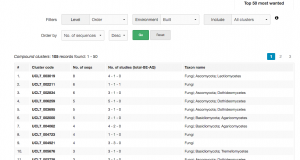
In this new paper in MycoKeys we present a set of automatically updated lists of the most abundant fungal species hypotheses known from sequence data, but for which little to no taxonomic information is available.
If anyone can shed light on the taxonomic affiliation of these species hypotheses, we’d be all ears.
Through a “built environment” switch, the user can restrict the search to clusters of sequences where at least one sequence has a relation to the built environment (typically substrate or locality of collection; Fig. 1). The results show that the built environment indeed is a source of fungi that cannot be identified to order, class, or even phylum level (Fig. 2).
It is very frustrating, in the year 2016, not to be able to assign a fungal sequence even at the phylum level. These lists seek to put the spotlight on these poorly understood parts of the fungal tree of life. By bringing these lineages to the surface, we hope to speed up their taxonomic recognition and formal description. Until they have a formal Latin name, we provide a DOI for them (and all other fungal species hypotheses known from sequence data). This makes unambiguous communication and data mining on species possible across scientific studies and datasets.
Some of the lineages are probably already known to science, but have not yet been sequenced (or their sequences are withheld). This lack of available reference data makes taxonomic identification troublesome at present. We hope that anyone who sits on information on the taxonomic affiliation of these lineages would be willing to share that information through the third-party sequence annotation facilities of UNITE. We will share any such contributed information with all resources that rely on UNITE for reference data without delay.

In a Sloan-funded workshop in Gothenburg (Sweden, May 2016) we hope to go through all public fungal ITS sequences with a relation to the built environment and annotate them according to the MIxS-BE metadata standard. This will, among other things, increase the scientific explanatory power of these “Top 50” lists further.